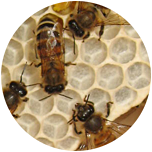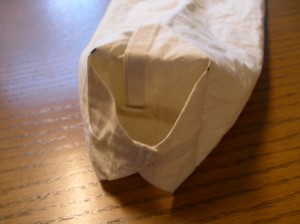Orginally published on the Glenbrook North Zero Waste Blog (more about them at the end).
 I keep a lot of my dry goods in glass jars to keep them fresh and safe from insects. And, of course I hate garbage, so I like to buy in bulk. The thing is, it is annoying to buy five cups of corn meal from the bulk bin when my jar will only hold four cups—I needed a graduated bag to help me buy the right amount for my jars.First World Problem alert!!
I keep a lot of my dry goods in glass jars to keep them fresh and safe from insects. And, of course I hate garbage, so I like to buy in bulk. The thing is, it is annoying to buy five cups of corn meal from the bulk bin when my jar will only hold four cups—I needed a graduated bag to help me buy the right amount for my jars.First World Problem alert!!
I started with a piece of unbleached cotton pillow ticking 20” tall and 13” wide. The ticking is intended to hold feathers, so the fabric is woven tightly enough that I can buy flour and not have it leak all over the place. I also designed this bag to not have any hidden corners to trap dry goods.
Wash and dry your fabric to shrink it before sewing.
First I tore a one inch strip off the long side for my tie. I pressed the edges in to the centre, then folded and pressed the tie in half again to make a long narrow strip with no raw edges before I sewed it closed.
Tearing off the edge for the tie left me with a piece 20” by 12”. I wanted to have the seams on the outside so nothing would get caught inside the bag, so I used a French, or lingerie, seam. For normal sewing, you put your fabric right sides together to sew the seam, then turn your piece inside out for the finished item, and for a French seam you put wrong sides together. So for the French seam to end up on the outside, you still put the right sides together, and sew a seam ¼” from the edge. Then turn it inside out and sew a 3/8” seam. Now you have a finished seam on the outside of the bag.
 Fold and press the top edge over twice and seam it—again so that it is on the outside of the bag. No flour or corn meal will get caught in the fabric when you dump it into your jar.
Fold and press the top edge over twice and seam it—again so that it is on the outside of the bag. No flour or corn meal will get caught in the fabric when you dump it into your jar.
Now flatten the fabric tube, fold the bottom end over twice and seam on the outside. Now you have a bag, but we are going to make it even better.
If you put a square of cardboard inside your bag, flat on the bottom, you will see two triangular little ears on the bottom of the bag. These are just like the little triangular ears you see on a drink box or Tetra Pak. You want to sew two seams to close off those triangular little ears. This eliminates two annoying little corners inside your bag that lentils would get caught inside.
Design Alert!!
I said if you put a square of cardboard inside your bag, you will see two triangular ears. But, if you put a rectangular piece inside, the ears will be long enough to overlap. Then, if you sew the ears together you get a great little handle on the bottom of your bag to help you shake the flour out of your bag. My rectangle ended up being 3 ½” by 2 ¼”, but try it out for yourself.
 Your bag should be done now. Measure something like rice or beans into the bag, one cup at a time. Make marks for each cup with a permanent marker. Sew the tie on and enjoy shopping your bulk section.
Your bag should be done now. Measure something like rice or beans into the bag, one cup at a time. Make marks for each cup with a permanent marker. Sew the tie on and enjoy shopping your bulk section.
Glenbrook North was a community group I helped support while I was working at Metro Vancouver, and I want to share a little anecdote about this suburban cul-de-sac.
Metro provided a little infrastructure–signage and couple of composters, and the GNNWC was expected to weigh all their garbage and give Metro the data. So, while I was crunching the data I started feeling kind of sick—their recycling rate was plummeting. This was not good. But, as I continued, I found garbage was also plummeting. They weren’t recycling much because they had hardly any garbage of any kind. It was the Holy Grail of garbage, they had changed their consumption.


[…] If you are into bulk food—and I hope you are—may I introduce you to my fine design for a reusable, measuring, bulk food bag? […]
If only you could make theses to sell. 😉
I would be happy if someone would. Since I have been sewing for so long, I am terribly cheap when it comes to buying small items like this.
such a really really great share. i must do this. thank you~ an exciting way to cut down on a lot of bulk bags.